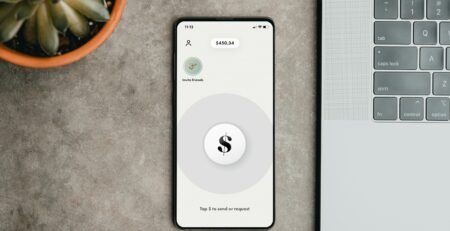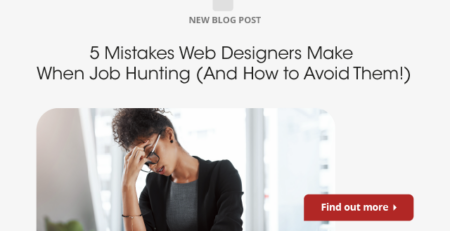The Competitive Edge: How to Outshine Other UX/UI Designers in Your Industry
A growing number of industry experts are talking about a hiring spike in the UX/UI design field. Some revelations from the Bureau of Labor Statistic’s latest jobs report indicate that this growth may already be starting, in large part due to companies’ mad rush to get their business models and supply chains online. User experience (UX) design comes into play whenever a business wants to build an app, create a website, or even use its social media accounts to the fullest.
Among this influx, many UX professionals are scrambling to find out how to be the best designer they can be before they get flooded out of the labor pool by newcomers. Luckily, if you’re already a UX/UI designer you likely have a slight leg up on people who haven’t finished their education yet. But lest you create a tortoise and the hare situation for yourself, it’s imperative to keep that competitive advantage.
Competing as a designer can be difficult because many people in non-creative positions don’t understand exactly what user-centered design is all about. The deliverables many managers use to measure UX designers’ progress often look similar to those who don’t understand the nuance of the individual designs.
Like it or not, that’s always been part of creatives’ jobs and it’s going to stay that way. After all, if managers and other workplace decision-makers or non-creatives understood all the ins-and-outs of UX design, there never would have been a separate job created for it in the first place.
One of the best UX/UI design tips that will go the furthest in helping you stand out in the crowd is to hone your communication skills until you can be more effective in less time than the competition. Nothing will help you help a company (or get through a design test) better than being able to clearly and quickly define exactly what the research says, what the design should be, and why it will work.
That includes your thought process. Too often, creatives are paralyzed by indecisiveness. In all likelihood, this stems from the very path that led us to be creatives in the first place. The business world and society at large hold creativity to a strange and separate standard than, say, science or math. The journey to become a creative is often fraught with uncharted paths that can cause creatives to doubt themselves.
If you want to try competing as a designer, you must do whatever you can to rid yourself of this automatic response. Not all second-guessing is bad in the iterative design process, but when you have to communicate, it’s imperative to know your design inside and out so you can explain its strengths, limitations, and how you came to create it. That’s the key to great case studies and great design itself.
There are many more UX/UI design tips that will help you pull ahead of the herd in your industry. This guide is filled with the most effective ones. If you want to know how to be the best designer you can be, read through this guide and start putting these UX/UI design tips to good use.
What is User-Centered Design (and What Do Businesses Think It Is)?
Let’s go back to school a little bit and discuss exactly what the goals of user experience and interface design are and what companies usually think they are.
User-centered design is the way we discover exactly who will use a product to solve what kind of problems in what way. UCD comprises a laundry list of methods that allow us to deep-dive into the product and design its every facet. Long gone are the days where novel inventions alone can stir up attention. Product users have become accustomed to digital interfaces and their design to such a degree that they’ll reject any design that isn’t streamlined, intuitive, and error-free.
In many cases, companies are stuck in the mindset that you have to make the pitch and sell the product. A few decades ago, that was still mainly true. Now, that sort of direct pitch is hardly even acceptable in polite society. It’s the hallmark of a swindler. Successful modern companies find a way to present their clientele with a product before the product, and that’s what UCD is.

A Product Before the Product
When we’re customers in the digital sphere, we rarely go looking for something directly. The internet is such a large milieu that we’re frequently browsing without even knowing it. The design of the internet seems to encourage this behavior more than anything else.
Content writers and managers know that traffic follows legitimate interesting content. Information about the product or its general subject matter is a great way to create an informed customer base and direct them to some call to action, most likely a shopping cart function.
So, in essence, the design is the first product for the company. It’s the face of the brand and it’s almost always free to see. Before there’s even a mention of the actual product, the prospective buyer can be immersed in a website or app that holds their attention until the critical moment. For that to work, the designer has to understand the real users and their goals in addition to those of the company.
Competing as a Designer On a Team
To some degree, all UX/UI designers have some camaraderie in the sense that they use similar tools to accomplish similar goals. This is especially true when there are multiple designers within the same art department. Things can get a bit dicey if the sense of competition overrides the team dynamic. You’ll likely find that building a working design is pretty much impossible if everyone on the team is trying to one-up each other to get some attention from the top brass.
Teamwork can be a kind of finger trap in that sense. The best way to ‘compete’ on a team is to foster constructive teamwork. Of course, it’s always possible that facilitating another’s creativity will allow them to outshine the rest of the team. But if the alternative is to kill the design, thereby making the whole team look bad, then everyone will get attention from management – just not the positive kind.
UX Research: Who Is the User?
The growing ubiquity of the internet and all things digital makes it too easy to fall into the trap of referring to The User, or users in general, as a uniform monolith. UX research is specifically geared at finding out who exactly the user is, but you’ll have to know what you’re looking for if you want the most accurate results. Here are a few things to look out for:
- The User Isn’t the Ideal User
Don’t try and create a target for a product or design that already exists. That’s a surefire path to destruction for your project. Whoever your user is, they’re out there living real lives and you have to meet them where they’re at if you want to appeal to them at all.
The company probably has an ideal user in mind for their product. If the product has a broad appeal, you still need to find out who is going to use the design to get access to the product. A soda, for example, might be enjoyed by kids and adults alike, but which group is going to use the website?
- Discover the Environment
There are many facets of the environment in which a user will experience the design. User research needs to find out the specific needs of the user and determine which of these needs are conscious and unconscious. For example, if a user is multitasking when they use a design, they might need something more streamlined or they might need placeholders like bookmarks, saved shopping carts, or a favorites list.
What’s important to note about these features is that the user might not be aware of how much they need them until they’re available for use. This aligns pretty well with the famous edict that successful design should be invisible to the user. If they notice something is lacking, chances are it’s already too late to make the sale.
- Make the Design Predictable
Part of what we mean when we say a design should be intuitive is that users should be able to guess what will happen on their way through the design even if they’ve never seen anything like it before. Granted, there will be a learning curve on more complex design products, but there should be navigational hints built into the design so that they can figure out how to get to the next page.
Make sure it’s clear what’s clickable and what’s not. Also, make it obvious what each click will do. For example, all menu items that slide out when clicked should look the same or similar. Important buttons and irreversible actions should be delineated, possibly with a warning that the action is permanent. Don’t let the user get into a situation where they’ve suddenly bitten off more than they can chew.
How to Be the Best Designer: UX/UI Design Tips that Will Help You Shine
Competing as a designer is kind of a confusing thought because you mostly don’t know what exactly the competition is coming out with until it’s public. If you look at it the right way, though, there are a few key things you can do to make sure you’re staying on the cutting edge and producing work that’s top of its class.
1- Stay Informed
People are dreaming up new design tactics all the time. New books on design thought are coming out by the hundreds each year and if you want to stay ahead of the competition you have to keep aware of what people in the industry are talking about.
In addition to reading books on design thought, you should also look out for seminars and other training sessions for new software and other tools that will help you implement new ideas. If you fail to do that, you could lose out to the competition just because your turnaround isn’t as fast.
2- Don’t Fixate on Deliverables
Management and even the head of the art department always like to see wireframes and personas because it shows them that the UX/UI designer has been working. However, part of competing as a designer effectively means you should concentrate on quality and not quantity of such deliverables. If you’re sprinting through iterations of prototypes or constantly developing new information structures, it’s going to make you look less effective to savvy management, not more.
Don’t let these deliverables speak for themselves. Remember that they’re for the designers to organize information and turn it into the final design product. When you show them to higher-ups, they’re visual representations that you can use to help communicate your ideas. Use them to accomplish that critical goal of all storytelling, showing and not telling.
3- Build a Great Case Study
Your work product doesn’t just help you find new jobs. It’s also a treasure trove you can look to later if you need some inspiration. Just like your deliverables are illustrations to help your communication with other members of the art department or company at large, your case studies can help demonstrate ideas to everyone, even fellow designers.
If you aren’t sure how to build a great case study, practice organizing one with invented information. Better yet, create a sample product. That way, you can use the case study as part of your portfolio when you finish.
4- Stay in Constant Communication
This goes for the design team and the stakeholders alike. Even if you’re in a remote work position, you have to make sure everyone knows how to reach you and vice versa. Keeping open communication will help generate better ideas and let those higher-ups know what the art department is up to without having to drop in and check, which everyone will enjoy much more.
In terms of outshining the competition, making yourself available to talk to is one of the best ways to become a contact person. That makes you the face of the project if there isn’t one already established. Keeping your team updated with information will help everyone be successful and prevent surprises.
5- Network
There’s no other way to know what you’re up against unless you know what’s happening in the industry. This is one of those UX/UI design tips that seem obvious, and it does kind of play into the open communication and staying informed tips. But networking is most importantly the way you can talk to people from outside your firm to find out what they’re working on and what they’re worried about.
Networking isn’t about being a snake in the grass. Rather, you should be networking to build new connections and hopefully let some brilliant new design ideas germinate. For many creatives, this is easy to do because there’s a legitimate interest in the craft. Networking will help you build a name for yourself. That kind of personal brand is invaluable for staying ahead of the curve.

6- Specialize
If you’re wondering how to be the best designer of all time, you might need a little grounding. Another way you can build up a personal designer brand is to focus on the strongest points in your work. The trick is to do this without pigeonholing yourself into a fixed role that won’t allow you to progress in your career.
While it obviously won’t be possible to make all of your designs thematically similar, there should be elements that enable people to identify it as your handiwork. Once you figure out how best to do that, you’ll likely have found your voice as a UX designer. That’s the kind of thing companies love so long as you’re still giving them the effective product they need. And these companies will pay top dollar for UX design that stands out with such a clear voice.
Conclusion:
If you want to know how to be the best designer you can be, it’s not a big secret. Just concentrate more on yourself and your voice as a designer and it’ll be much easier to consistently create deliverables and final designs that make you stand out against the competition. While you shouldn’t let your work stand alone or speak completely for itself, effective UCD will drive traffic and sell so many products that people won’t be able to help to notice.












